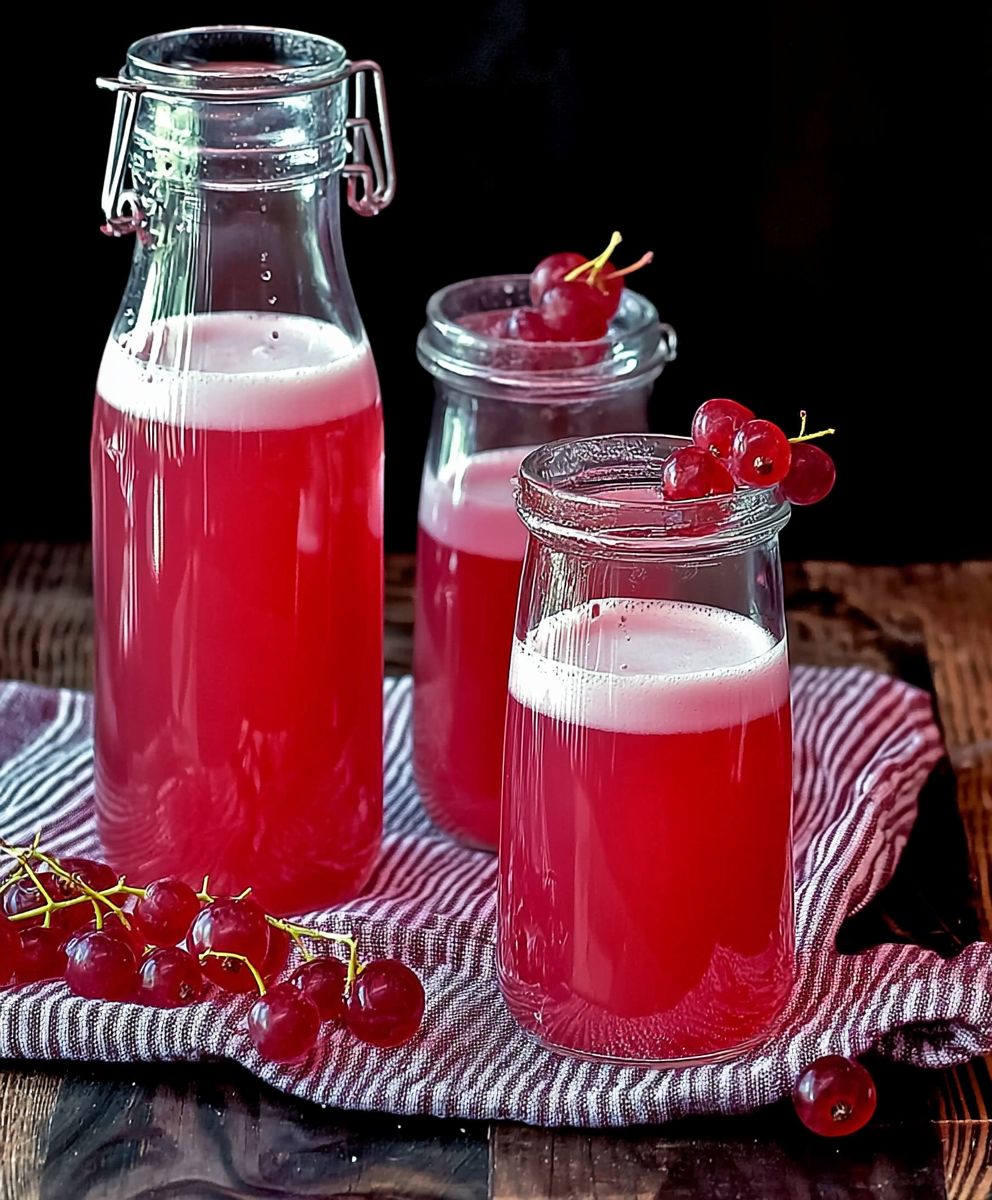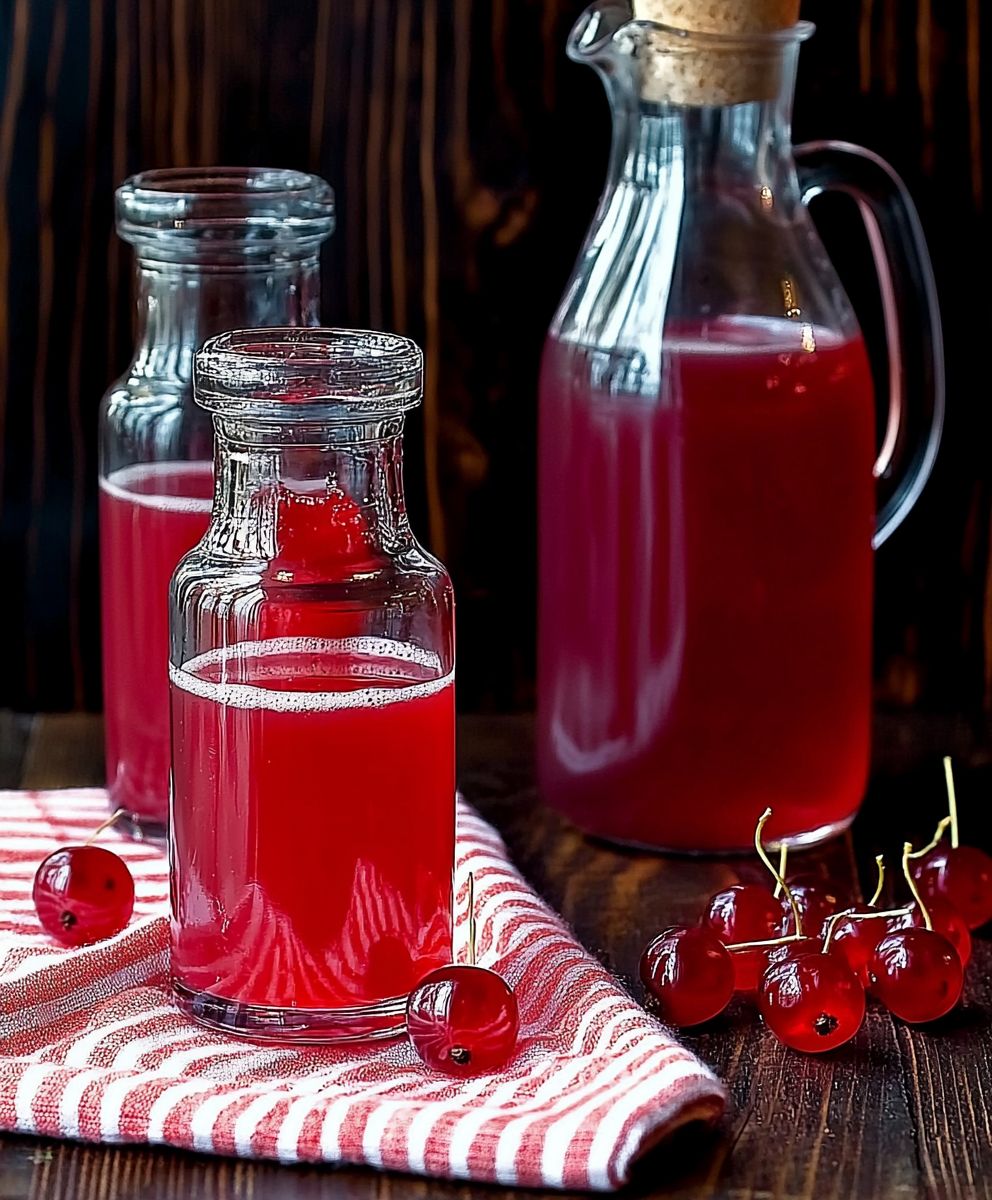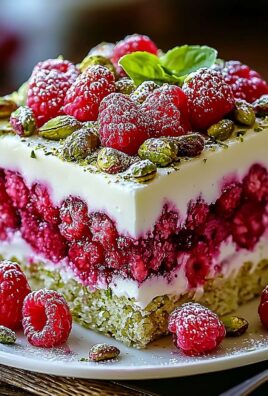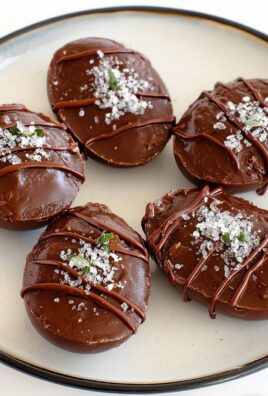Redcurrant syrup: a taste of summer bottled for year-round enjoyment! Imagine drizzling a vibrant, ruby-red elixir over your morning pancakes, stirring it into sparkling water for a refreshing spritzer, or using it to glaze a succulent roast chicken. This isn’t just a recipe; it’s a portal to sun-drenched gardens and the tart-sweet burst of perfectly ripe redcurrants.
Redcurrants, with their jewel-like appearance, have been cultivated in Europe since the 16th century. Historically, they were prized not only for their unique flavor but also for their medicinal properties. While fresh redcurrants are a fleeting summer treat, transforming them into a luscious redcurrant syrup allows us to savor their goodness long after the harvest is over.
What’s not to love? The intense, slightly acidic flavor of redcurrants is perfectly balanced by the sweetness of sugar, creating a syrup that’s both complex and incredibly versatile. It’s quick and easy to make, requiring only a few simple ingredients and minimal effort. Plus, the vibrant color adds a touch of elegance to any dish or drink. So, are you ready to capture the essence of summer in a bottle? Let’s get started!
Ingredients:
- 1 kg fresh redcurrants, stemmed and washed
- 500g granulated sugar (adjust to taste, depending on the tartness of the currants)
- 250ml water
- 1 tablespoon lemon juice (optional, but helps with preservation and brightness)
- Sterilized bottles or jars for storage
Preparing the Redcurrants:
- Wash and Stem the Redcurrants: Gently wash the redcurrants under cold running water to remove any dirt or debris. Carefully remove the stems. This can be a bit tedious, but it’s important for a smooth syrup. I usually do this over a large bowl to catch any stray currants.
- Crush the Redcurrants: In a large, heavy-bottomed saucepan, crush the redcurrants slightly. You can use a potato masher or the back of a wooden spoon. This helps to release their juices and flavor. Don’t overdo it; you just want to break them down a bit.
Cooking the Syrup:
- Add Water and Sugar: Add the water and sugar to the saucepan with the crushed redcurrants. Stir well to combine. Make sure the sugar is evenly distributed.
- Bring to a Boil: Place the saucepan over medium heat and bring the mixture to a gentle boil, stirring occasionally. This is crucial to dissolve the sugar completely. Keep stirring until you no longer feel any sugar granules at the bottom of the pan.
- Simmer and Cook: Once boiling, reduce the heat to low and simmer gently for about 20-30 minutes, or until the redcurrants have softened and released their juices. Stir occasionally to prevent sticking and burning. You’ll notice the mixture thickening slightly as it cooks. The color will also deepen to a beautiful ruby red.
- Check for Doneness: To check if the syrup is ready, place a small spoonful of the liquid onto a cold plate. Let it cool for a few seconds. If it wrinkles slightly when you push it with your finger, it’s ready. If it’s still too runny, continue simmering for a few more minutes and test again. Remember that the syrup will thicken further as it cools.
- Add Lemon Juice (Optional): If using, stir in the lemon juice during the last 5 minutes of simmering. This will add a touch of brightness and help preserve the syrup.
Straining the Syrup:
- Prepare the Straining Setup: Place a fine-mesh sieve or a cheesecloth-lined colander over a large bowl. Make sure the sieve or colander is stable and won’t tip over when you pour the hot syrup into it.
- Strain the Syrup: Carefully pour the hot redcurrant mixture through the sieve or cheesecloth. Allow the syrup to drip through naturally. Don’t press on the solids too much, as this can make the syrup cloudy. If using cheesecloth, you can gently gather the edges and squeeze lightly to extract more juice, but be mindful of cloudiness.
- Discard the Solids: Once all the syrup has dripped through, discard the solids (the redcurrant pulp and seeds). You can compost them or discard them in the trash.
- Optional: Second Straining for Extra Clarity: For an even clearer syrup, you can strain it a second time through a clean cheesecloth. This will remove any remaining tiny particles.
Bottling and Storing the Syrup:
- Sterilize Bottles or Jars: This is a crucial step to ensure the syrup stays fresh for longer. There are several ways to sterilize bottles:
- Boiling: Place the clean bottles and lids in a large pot of boiling water for 10 minutes. Carefully remove them with tongs and place them upside down on a clean towel to dry.
- Oven: Preheat your oven to 120°C (250°F). Place the clean bottles and lids on a baking sheet and bake for 10 minutes. Let them cool slightly before handling.
- Dishwasher: Run the bottles and lids through a hot dishwasher cycle with a sanitizing option.
- Fill the Bottles: While the bottles are still warm (but not too hot to handle), carefully pour the hot redcurrant syrup into the sterilized bottles, leaving about 1/2 inch of headspace at the top. A funnel can be helpful to avoid spills.
- Seal the Bottles: Wipe the rims of the bottles clean with a damp cloth. Place the sterilized lids on the bottles and tighten them securely.
- Process for Longer Shelf Life (Optional): For a longer shelf life, you can process the filled bottles in a boiling water bath. Place the filled and sealed bottles in a large pot of boiling water, ensuring they are completely submerged. Boil for 10 minutes. Carefully remove the bottles with tongs and place them on a towel-lined surface to cool completely. As they cool, you should hear a “pop” sound, indicating that the lids have sealed properly.
- Cool and Store: Let the bottles cool completely before labeling them with the date and contents. Store the unopened bottles in a cool, dark place. Once opened, store the syrup in the refrigerator.
Tips and Variations:
- Adjusting Sweetness: The amount of sugar can be adjusted to your preference. If you prefer a tarter syrup, use less sugar. If you prefer a sweeter syrup, use more. I recommend starting with the suggested amount and adjusting to taste after the syrup has simmered for a while.
- Adding Spices: For a more complex flavor, you can add spices such as cinnamon sticks, cloves, or star anise to the syrup while it simmers. Remove the spices before straining the syrup.
- Using Frozen Redcurrants: If fresh redcurrants are not available, you can use frozen redcurrants. Thaw them slightly before using.
- Serving Suggestions: Redcurrant syrup is delicious drizzled over pancakes, waffles, or ice cream. It can also be used to flavor cocktails, mocktails, or sparkling water. You can even use it as a glaze for meats or poultry. I love adding a splash to my morning yogurt!
- Troubleshooting Cloudy Syrup: If your syrup is cloudy, it could be due to over-squeezing the redcurrant pulp during straining or using tap water with high mineral content. Try straining the syrup again through a clean cheesecloth and using filtered water next time.
- Shelf Life: Properly sterilized and sealed bottles of redcurrant syrup can last for up to a year in a cool, dark place. Once opened, the syrup should be stored in the refrigerator and used within a few weeks.
Detailed Explanation of Redcurrant Qualities:
Redcurrants are small, tart berries that grow in clusters on shrubs. They are known for their vibrant red color and their slightly acidic flavor. Redcurrants are a good source of vitamin C, antioxidants, and fiber. They are often used in jams, jellies, sauces, and desserts. The tartness of redcurrants makes them a perfect counterpoint to sweet dishes, and their bright color adds a beautiful visual appeal. When selecting redcurrants, look for berries that are plump, firm, and evenly colored. Avoid berries that are shriveled, bruised, or moldy.
Why Sterilization is Key:
Sterilizing your bottles and jars is absolutely essential for preserving your redcurrant syrup. This process eliminates any bacteria, yeasts, or molds that could spoil the syrup and make it unsafe to consume. Without proper sterilization, your syrup could develop mold, ferment, or simply go bad within a short period of time. Taking the extra time to sterilize your equipment ensures that your hard work and delicious syrup will last for months to come.
Understanding the Science of Syrup Making:
Making syrup is a simple yet fascinating process that relies on the principles of sugar concentration and preservation. When you heat sugar and water together, the sugar dissolves and creates a solution. As the mixture simmers, water evaporates, increasing the concentration of sugar. This high sugar concentration acts as a natural preservative, inhibiting the growth of microorganisms that could spoil the syrup. The addition of lemon juice further enhances the preservation process by increasing the acidity of the syrup, making it even less hospitable to bacteria and molds. The final product is a sweet, flavorful syrup that can be enjoyed for months, thanks to the power of sugar and heat.
Creative Uses Beyond the Obvious:
While redcurrant syrup is fantastic on pancakes and ice cream, its versatility extends far beyond these classic applications. Consider using it to create a sophisticated cocktail by adding a splash to gin and tonic or vodka soda. It can also be used to make a refreshing summer drink by mixing it with sparkling water and a squeeze of lime. In the

Conclusion:
This redcurrant syrup recipe isn’t just another recipe; it’s a gateway to a summer garden in a bottle, a burst of sunshine you can enjoy all year round. I truly believe you must try it. The vibrant color, the tangy-sweet flavor it’s simply irresistible. Forget those store-bought syrups loaded with artificial flavors and preservatives. This homemade version is pure, natural goodness, and the taste difference is remarkable. It’s so easy to make, even if you’re a beginner in the kitchen, you’ll be amazed at how quickly you can whip up a batch of this liquid gold.
But why is this redcurrant syrup a must-try, you ask? Because it’s incredibly versatile! Imagine drizzling it over pancakes or waffles for a delightful breakfast treat. Picture yourself stirring it into sparkling water or lemonade for a refreshing summer drink. Think of the possibilities! You can even use it to glaze grilled chicken or pork for a sweet and savory twist. It’s fantastic in cocktails, adding a fruity depth to your favorite concoctions. And for the dessert lovers out there, try swirling it into yogurt, ice cream, or even cheesecake batter. The possibilities are truly endless!
Serving Suggestions and Variations:
Don’t be afraid to experiment! For a spicier kick, add a pinch of chili flakes to the syrup while it’s simmering. A sprig of rosemary or thyme can infuse it with a subtle herbal note. If you prefer a smoother syrup, strain it through a fine-mesh sieve after cooking to remove any remaining pulp.
Here are a few of my favorite ways to use this delicious syrup:
* Redcurrant Syrup Spritzer: Mix a tablespoon of syrup with sparkling water and a squeeze of lime for a refreshing and healthy drink. Garnish with fresh mint leaves.
* Redcurrant Glazed Chicken: Brush the syrup over chicken breasts during the last few minutes of grilling for a sweet and tangy glaze.
* Redcurrant Yogurt Parfait: Layer yogurt, granola, and a drizzle of syrup in a glass for a quick and easy breakfast or snack.
* Redcurrant Cocktail: Add a splash of syrup to your favorite gin and tonic or vodka soda for a fruity twist.
And if you’re feeling adventurous, try making a redcurrant vinaigrette by whisking together the syrup with olive oil, vinegar, and Dijon mustard. It’s perfect for salads or as a marinade for grilled vegetables.
I’m confident that once you try this recipe, you’ll be hooked. It’s a simple yet elegant way to elevate your everyday meals and drinks. It’s also a wonderful way to preserve the taste of summer and enjoy it throughout the year.
So, what are you waiting for? Gather your redcurrants (or buy them from your local farmer’s market), and get ready to create something truly special. I promise you won’t regret it.
I’m so excited for you to try this recipe! Once you’ve made your own batch of this amazing redcurrant syrup, please come back and share your experience in the comments below. I’d love to hear how you used it, what variations you tried, and what you thought of the flavor. Did you add any special ingredients? Did you create a new and exciting recipe using it? Your feedback is invaluable, and it helps me to create even better recipes in the future. Happy cooking (and sipping)!
Redcurrant Syrup: The Ultimate Guide to Making & Using It
Vibrant and tart homemade redcurrant syrup, perfect for desserts, drinks, or savory dishes. Easy to make and preserve, capturing summer's bright flavor.
Ingredients
- 1 kg fresh redcurrants, stemmed and washed
- 500g granulated sugar (adjust to taste)
- 250ml water
- 1 tablespoon lemon juice (optional)
- Sterilized bottles or jars for storage
Instructions
- Prepare Redcurrants: Wash and stem redcurrants. Crush them slightly in a large, heavy-bottomed saucepan.
- Cook the Syrup: Add water and sugar to the saucepan. Bring to a gentle boil, stirring until sugar dissolves. Reduce heat and simmer for 20-30 minutes, or until redcurrants soften and the mixture thickens slightly.
- Check for Doneness: Place a small spoonful on a cold plate. If it wrinkles when pushed, it’s ready.
- Add Lemon Juice (Optional): Stir in lemon juice during the last 5 minutes of simmering.
- Strain the Syrup: Place a fine-mesh sieve or cheesecloth-lined colander over a bowl. Pour the hot mixture through, allowing it to drip through naturally. Discard the solids. For extra clarity, strain a second time.
- Sterilize Bottles/Jars: Sterilize bottles by boiling, baking in the oven at 250°F (120°C) for 10 minutes, or using a hot dishwasher cycle.
- Fill the Bottles: Carefully pour the hot syrup into the sterilized bottles, leaving 1/2 inch of headspace.
- Seal the Bottles: Wipe the rims clean, place sterilized lids on the bottles, and tighten securely.
- Process for Longer Shelf Life (Optional): Process the filled and sealed bottles in a boiling water bath for 10 minutes.
- Cool and Store: Let the bottles cool completely before labeling. Store unopened bottles in a cool, dark place. Once opened, refrigerate.
Notes
- Adjust sugar to taste.
- Add spices like cinnamon, cloves, or star anise while simmering for a more complex flavor. Remove before straining.
- Frozen redcurrants can be used (thaw slightly first).
- Serve drizzled over pancakes, waffles, or ice cream. Use to flavor cocktails, mocktails, or sparkling water. Use as a glaze for meats or poultry.
- If syrup is cloudy, strain again through cheesecloth and use filtered water next time.
- Properly sterilized and sealed bottles can last up to a year in a cool, dark place. Once opened, store in the refrigerator and use within a few weeks.





Leave a Comment